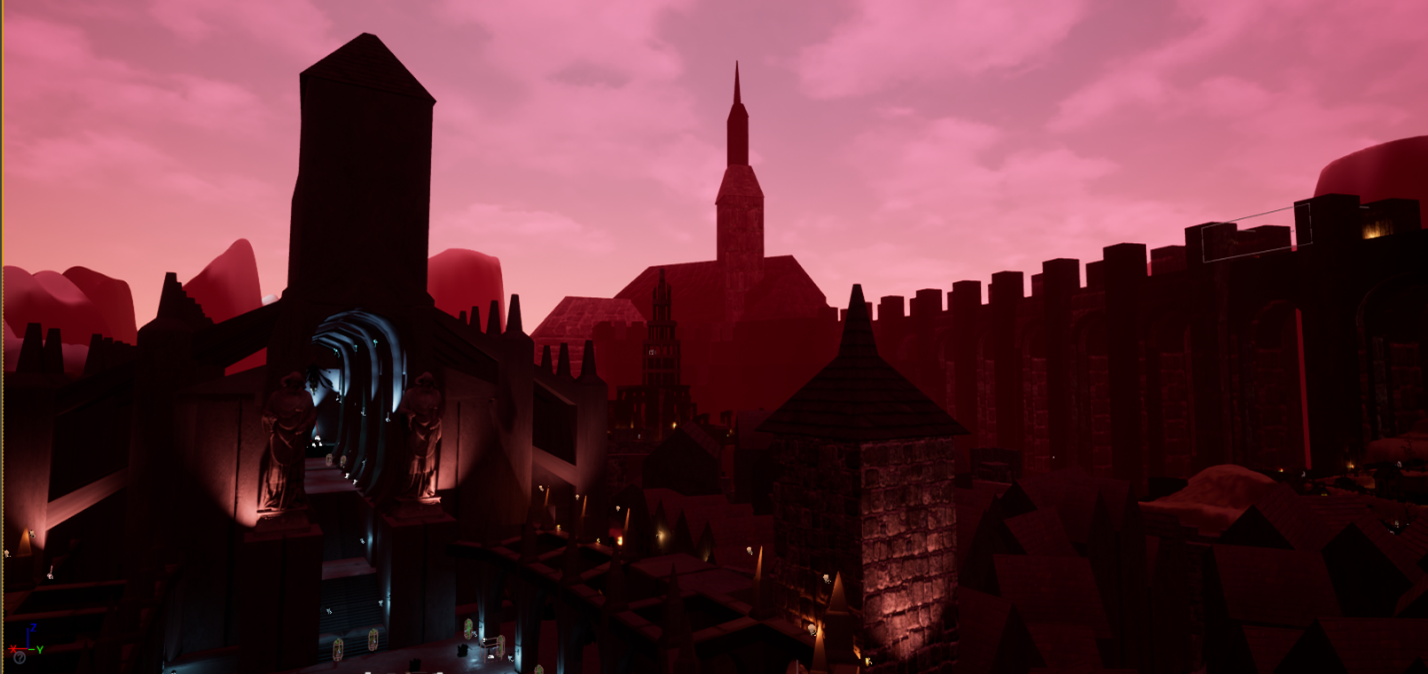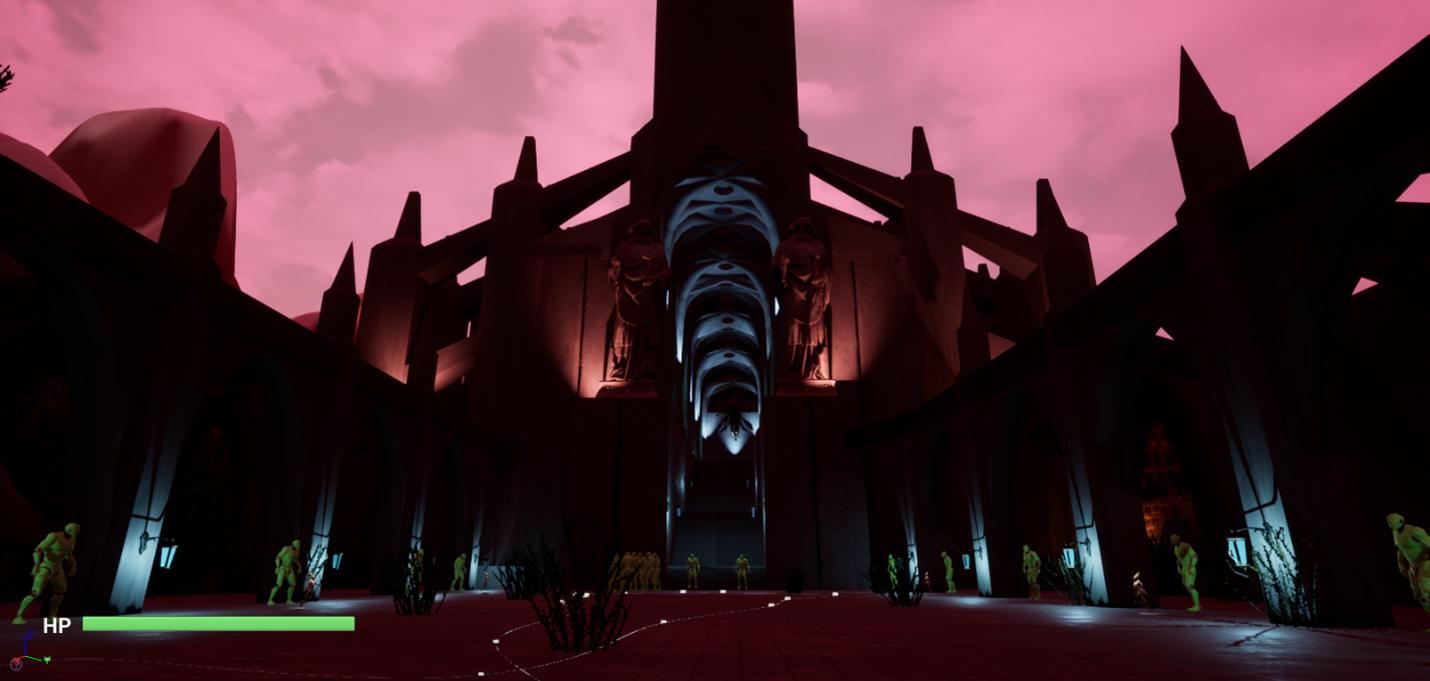Escape from Alder´s Town
Role: Level design, modeling, dressing and basic scripting
Game Engine: Unreal Engine 4
Genre: Survival horror, Soulslike, Horror, Action
Overview
Escape from Alder Town is a level I made on my own for academic purpose. It´s the first level of a survival horror game, specially focused in creating a dark and hostile and memorable journey for the player to explore and experience. The player´s objective in this level is to find a way out of the town.
Design Logic
As the main approach of the level is to build up some hostile environment, I considered there should not be any map or hints to guide the player, creating a perception of vagueness and unknown. Instead, I opted for guidance based merely on architecture, composition and lighting as an incentive for the user to explore. With such premise, I structured the level as a maze to be discovered, and also as a “Molecule Level Space”, as defined by Luke McMillan and Nassib Azar in their Gamasutra article “The Metrics of Space: Molecule Design”, meaning there are several non-linear paths (edges) through the level and the player ought to find out how the spaces (nodes) are related to each other and determine the best way to navigate the map. It also allowed me to place denial points on the pathway connecting two spaces that can be overcame by creating shortcuts (Steiner points, as explained by McMillan and Nassib).
Organizing the landscape and guiding the player
After setting a general guideline for the level, I structured a layout regarding the spaces that I expected to set the environment and flow. For that purpose, I organized them in a node diagram that displays the importance of each space and the relation between them, as shown in the image below.

- The flow goes from the spawn point to any of the two exits points of the level, which are the entrances to the Geor´s Fortress.
- In order to open the exit gates, the player must retrieve either the Golden or Silver Key.
- The Golden key is kept at the Wotten´s Cathedral, and to get it, the player shall defeat the boss first (there´s nothing special about the bosses or any other enemy. They are there merely to indicate their placement and pacing along the game).
- The Silver key can be found at a dead end by the boundaries of the level. To get there is necessary to get through a different path and fight a different boss, so the way is unblocked.
- In the image above, the green lines represent some denial point placed on the path. Most of them are gates which must be opened by actioning a lever. After finding either a roundabout or the lever (Steiner point) that opens the gate, the player is now able to keep exploring or reach the point they were heading for.
- The multiple pathways mean that there are also multiple ways to reach the level point objective. I will explain three of the possible solutions to the level at the end.
Consequently, I structured the diagram into a more tangible map, following Kevin Lynch´s principles for making a city “legible”. As stated in his book, “The Image of the City”, the elements that guide a city are the districts, paths, nodes, landmarks and boundaries.
Districs
After several iterations, I organized the level as shown in the images below. All districts are designed to slowly guide the player towards the next district, so they eventually reach one of the two exits of the level. The most important districts are the ones holding boss battles, keys or gates.

Paths
The paths of the level are basically the connection between its spaces and ultimately determine the relationship between them. As mentioned before, I placed certain denial points along some paths, that can eventually be overcame by interacting with a lever that opens a gate blocking the main path and creates a more direct relation between spaces. In the image below, paths are shown in red:

Landmarks
Landmarks are probably the most important item of the level, since they are the beacon and guidepost that help the player decide where they should go and how to navigate the level. The landmarks here are The Wotten’s Cathedral, the tower at the Tauren´s Temple Ruins and the Geor´s Fortress, as shown below. Note that the landmarks (shown in red) are the spaces holding boss fights, keys, or level exits points.

Boundaries
The boundaries of the level are the rivers that separate parts of the town or the town from the spawning area, the mountains and the lake that work as barriers and contain the entire level, and Alder´s town walls which contain the town itself. Boundaries here explicitly differentiate districts and stablish “steps” to follow so the player can reach the landmarks.

Nodes
Nodes are basically the intersection between paths and are especially important here because they pose decision points. The most important nodes are highlighted below.
Spatial size types, pacing and lighting
I designed the spaces of the level and the relation between them as part of a whole “system”. The main criteria was structuring a pace based on the distances, alternance of environments, ways to navigate the landscape and placing of enemies and rewards. The image below shows the enemy and rewards positioning and the space types of each location. I adjusted all these aspects through several iterations to achieve an engaging journey which also encouraged exploring.

- To keep the interest in every space (as well as the pacing) I focused specially in space character, namely space size type, lighting and architectural configuration. As shown in the image above, there are three spatial size types, as explained by Christopher W. Totten in his book “An architectural approach to level design”.
- The narrow spaces are the ones which pose a lack of space to the player (dungeons, prisons).
- Intimate spaces let the player move freely in a “safe” way. They are in a certain way, contemplative (Tauren´s Lost Garden, Knight´s Store, Market square, Town´s yards, Alder Gardens).
- The prospect spaces are those which are very large compared to player´s character size, and usually related to boss fights, lobbies, or very large viewpoints (Alder´s Bridge, Wotten´s Cathedral, Tauren´s Temple Ruins, the open space of the level itself).
- The alternance of size types through the way helps “appreciate” every space by mere contrast between them. For instance, if the player were to go to Tauren´s Temple Ruins, they would have to do Dungeons-Open Space from Town-Tauren´s Lost Garden-Open Space form bridge-Tauren´s Temple which would be Narrow-Prospect-Intimate-Prospect-Intimate-Prospect.
- Another important tool to build up the experience is the relation between spaces and the way each space is approached. It varies depending on the experience and size type that wants to be posed. The image below shows a section view of the Lost´s Temple Ruins.

The player must approach the space from a higher ground, and when getting close to the stairs, the entire view opens as shown in picture 7 and 8. Lights here point to the ground and the columns, with the objective of making the space look taller and ethereal.

The approach to Wotten´s Cathedral is completely different. The player comes from a lower ground, to make the Cathedral look imposing and overwhelming, as shown in pictures 17 and 18. It´s a dark space, with soft blue lights pointing to the columns and ceiling so the space appears mysterious, quite dark and tall, just like a goth cathedral.

The approach to Wotten´s Cathedral is completely different. The player comes from a lower ground, to make the Cathedral look imposing and overwhelming, as shown in pictures 17 and 18. It´s a dark space, with soft blue lights pointing to the columns and ceiling so the space appears mysterious, quite dark and tall, just like a goth cathedral.
Gallery



Picture 3. Village entrance- First battle- Prospect space


Picture 5. Village-View to Alder´s Town- Open Prospect space




Picture 9. Lost´s ruins-Exterior view-Open Prospect space

Picture 10. Lost´s ruins-View form cemetery-Open Prospect space






Picture 16. View of the Castle and Bridge – Open Prospect space


